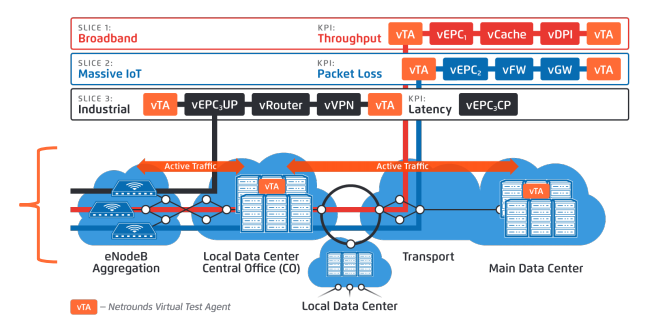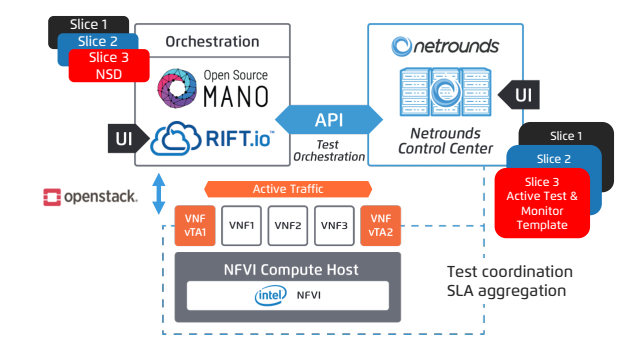We are in the last quarter of 2018 and we can see how extensively leading network equipment vendors, solution providers and communication service providers are indulged in moving a shift towards next generation of connectivity network i.e. 5G telecom. Such consideration for this shift leads to growing maturity and development in NFV technology driven by an active contribution by open source communities as well as work around new innovative proof of concepts jointly implemented by commercial vendors.
In this post, let’s talk about how DevOps methodology is implemented by vendors like Intel, Netrounds, Rift.io, Arctos labs with the help of ETSI’s Open Source MANO (OSM).
Challenge – Need for Service Assurance
On a roadmap of a scenario where multiple VNFs are chained together to create a network service and implementation of 5G feature i.e. network slicing wherein network channels are getting sliced to support different use cases to be enabled with 5G, service providers caring about ensuring and maintaining consistent quality of service to end users. After all, transformation to 5G is to provide a good customer experience which is the end goal for service providers. But transforming to 5G brings a great amount of complexity in network architecture and operations plus inclusion of shared environments; like for example VNFs deployed in VMs may need an update to enhance feature of service or it may be an immediate patch to avoid a glitch. Probably, such changes can be much frequent due to enablement of software nature in place of network equipments. To address the update, it will be difficult for service providers to perform manual testing and validation which may halt service delivery to active end customers. Service providers should ensure stability in service provision by active monitoring and testing at each phase network service. And, in case of network slicing feature, it becomes prominently critical for service provider where customer demand is aligning to use cases having low latency. Each of network slice has defined critical SLAs requirements to meet.
[Download eBook] 5G Architecture: Convergence of NFV & SDN Networking Technologies
So, summarizing the above, service provider need to
- validate critical SLA (matching customers and use cases) required by each of the network slices by actively monitoring and measuring metrics received at slices.
- Find out issues and resolve it in runtime without affecting the service delivery.
There is a gap between how you monitor/test network services and ensure the quality of services to customer and available tools and solutions.
PoC implementation to address challenge
To address the above challenges, it becomes imperative for service providers to have an active testing and validation that is highly automated by using programmable APIs in service chains and, end to end monitoring of services.
The PoC implemented by Telenor, Intel, Arctos Labs, Netrounds, Rift.io, and ETSI OSM addresses the above monitoring and service assurance concerns.
PoC utilized MANO for automated network service lifecycle management and end-to-end service activation, validation, and operations. DevOps approach is used for network operations and network service design plus enabling automation of deployment and maintenance of service chains and 5G slices.
The key feature of this demonstration is testing of new services is added at design time of network service or service chains. Adding to it, delivery or updates to new network services is verified during run time; if in case any update fails to execute, it can be roll back before reaching to customers.
PoC Architecture and example
As a sample case for this PoC, a network slicing scenario containing three different slices is considered which are having different type of characteristics, output for customers and KPIs to meet requirements from services that service providers are delivering. Here in this example, slices involved are: Mobile broadband having an important KPI as throughput, Massive IoT targeted KPI is packet loss and for industrial automation targeted KPI is latency.

ETSI Open Source MANO is used in conjunction with RIFT.IO’s RIFT.ware solution for NFV orchestration while OpenStack was used as the virtual infrastructure manager (VIM).

In order to test and assure the expected quality of service levels by network services and to be able to measure the KPIs of network slices, the Netround’s vTAs (virtual test agents) are deployed as part of the service. These test agents used for actively generate traffic, analyse details and for real-time measurements across service applications and interfaces. vTAs are controlled and updated remotely through Netrounds’ unifying Control Center hosted by at Netrounds end or on premises. Here is how the sample network service will look alike

Summary
For a large scale implementation of 5G network slices comprised of different but targeted service chains, an active end to end service assurance can be achieved with real-time monitoring and testing empowered with DevOps for automating operations. The key part of this PoC is the deployment of virtual test agents as part of network service chains to keep an eye during a lifetime of service. It can send real-time insight to control center about the health of the service.
You can get more details about this PoC from this whitepaper published on ETSI OSM website and watch a live demonstration here.
[Tweet “DevOps in NFV: Assuring Health of Service Chains and 5G Network Slices ~ via @CalsoftInc”]






